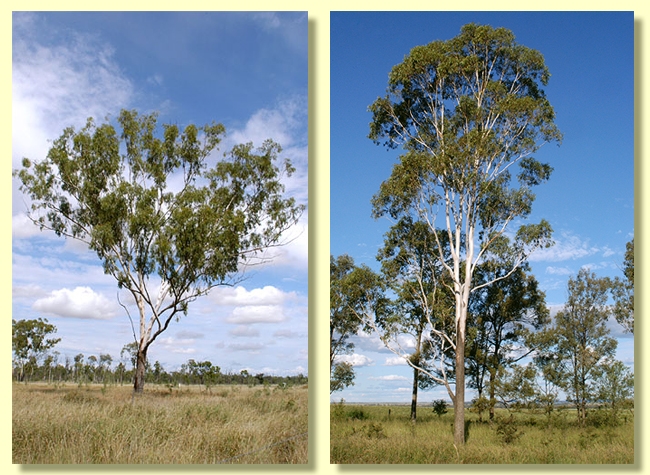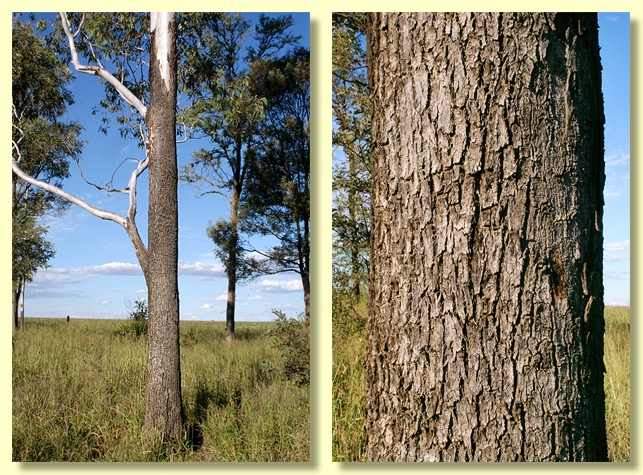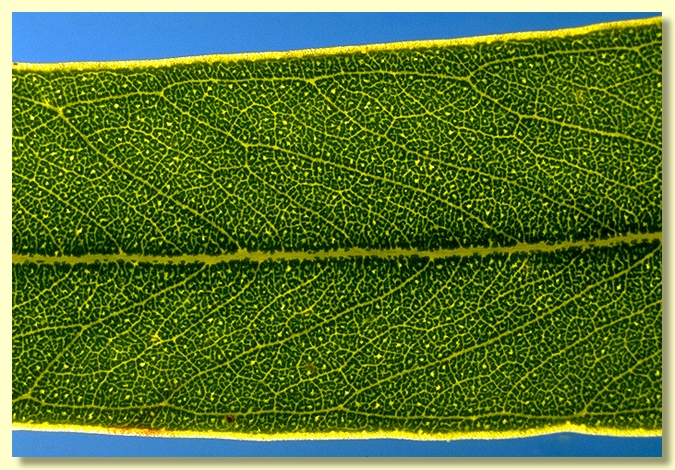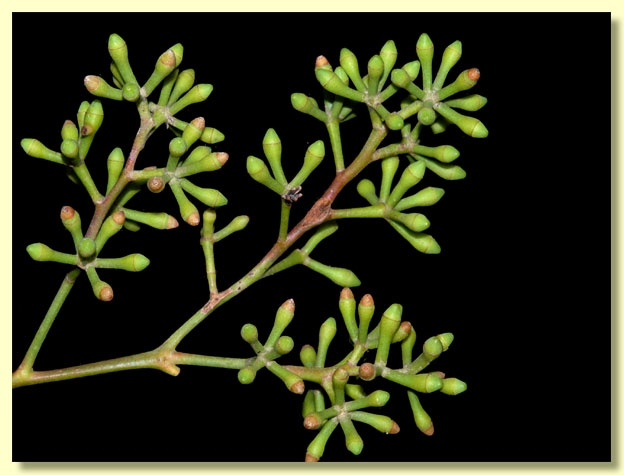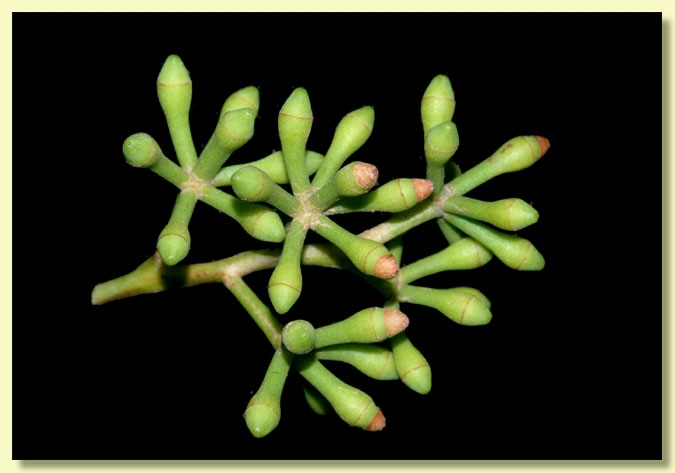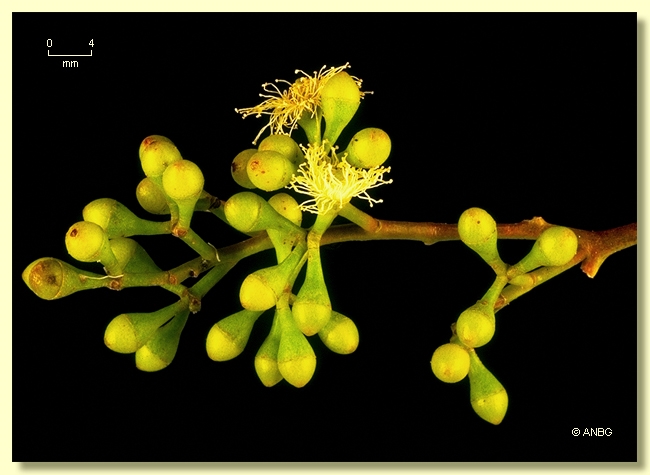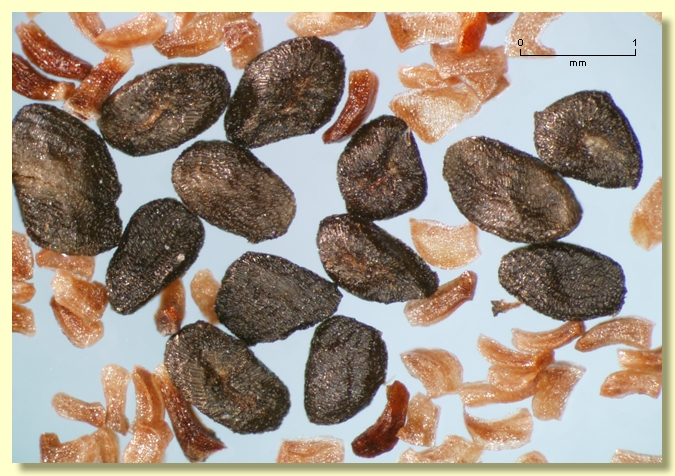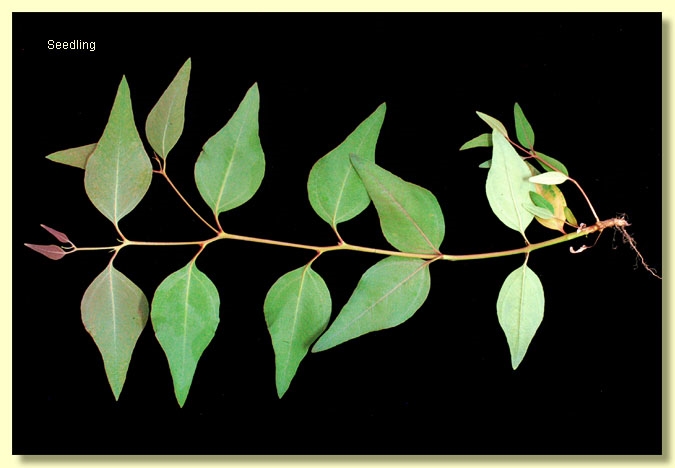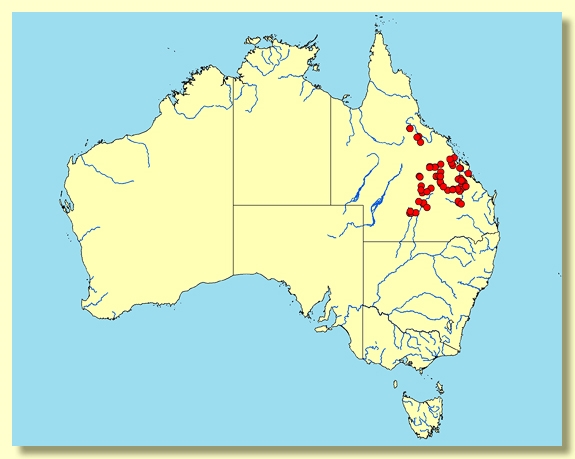Euclid - Online edition
Eucalyptus cambageana
Eucalyptus | Symphyomyrtus | Adnataria | Apicales | Buxeales | Amissae
Eucalyptus cambageana Maiden, J. & Proc. Roy. Soc. New South Wales 47: 91 (1913).
T: Queensland: Mirtna Station, [south of] Charters Towers, Z. Clark s.n., December 1912; Lectotype: (NSW332953; isolecto NSW332954); fide Bean, A.R., Telopea 12(4): 470 (2010).
Tree to 25 m tall. Forming a lignotuber.
Bark rough for 2 to 3 m on the lower trunk, usually hard, tessellated or box-type, dark grey to black with abrupt change to smooth bark, which is normally white to grey, rarely creamy pink to yellow.
Juvenile growth (coppice or field seedlings to 50 cm): stems square to round in cross-section; juvenile leaves petiolate, alternate, ovate, 7–14.5 cm long, 3–6.3 cm wide, base round to tapering to petiole, dull, blue-grey to rarely glaucous.
Adult leaves alternate, petiole 1–2.7 cm long; blade lanceolate to broadly lanceolate, sometimes falcate, 7.5–16.5 cm long, 1.2–3(4) cm wide, base tapering to petiole, concolorous, glossy, green, side-veins acute, reticulation dense, intramarginal vein parallel to and well removed from margin, oil glands intersectional or obscure.
Inflorescence terminal compound, peduncles 0.5–1.2 cm long, buds 7 per umbel, pedicels 0.3–0.6(1.1) cm long. Mature buds obovoid, 0.4–0.5 cm long, 0.2–0.4 cm wide, scar present, operculum conical to rounded, stamens irregularly flexed, staminodes absent, anthers adnate, basifixed, cuboid or globoid, style long, stigma blunt, locules 5, the placentae each with 4 vertical ovule rows. Flowers white.
Fruit pedicellate (pedicels 0.3–0.6(1.1)), cup-shaped to funnel-shaped, 0.3–0.6 cm long, (0.3)0.5–0.6 cm wide, disc descending, usually whitish, valves normally 5, enclosed or sometimes near the rim.
Seeds dark brown, 1–1.5 mm long, flattened-ovoid, sometimes pointed at one end, dorsal surface shallowly reticulate, hilum ventral.
Cultivated seedlings (measured at ca node 10): cotyledons small, reniform, green; stems square in cross-section, sometimes slightly warty; leaves always petiolate, opposite for 2 to 8 pairs then alternate, ovate, 5–10.8 cm long, 2.4–5 cm wide, base tapering or rounded, margin entire, apex pointed, dull, green to blue-grey, discolorous.
Flowering has been recorded in July, August and September.
A medium-sized tree endemic to eastern and central Queensland from north-east of Charters Towers, south-east through the Emerald–Clermont district, then eastwards towards the coast to just south of Sarina and then further south into the Biloela area, stretching then in a westerly direction through the Rolleston–Springsure area to just north of Tambo, with two disjunct areas further south, one in the Cracow region and the other extending from just north-west of Morven to west of Charleville. Eucalyptus cambageana is characterised by its rough box bark basal on the trunk and its conspicuously smooth bark on the upper trunk and branches, relatively broad ovate juvenile leaves, glossy green adult leaves, terminal inflorescences, buds with an operculum scar and no staminodes, and cup-shaped to funnel-shaped fruit to 0.6 cm wide with white disc.
Eucalyptus cambageana belongs to Eucalyptus subgenus Symphyomyrtus section Adnataria (the boxes) because the buds have two opercula, ovules are in four rows, seeds are flattened-ovoid, cotyledons are more or less reniform and anthers are rigid on the staminal filaments. Within section Adnataria, E. cambageana is part of a subgroup, series Buxeales, further distinguished by having rough bark, terminal inflorescences and buds that lose the outer operculum early. E. cambageana has 4 close relatives E. populnea in semi-arid eastern Australia, E. brownii from north-eastern Queensland, E. sparsa in Central Australia, and E. behriana from Victoria and south-central New South Wales. All have stamens irregularly arranged in bud and all fertile, and very glossy adult leaves. E. populnea is fully rough-barked and has broad adult leaves, E. brownii is also fully rough-barked and has very narrow juvenile and adult leaves, E. behriana is a partly rough-barked mallee with broad juvenile and adult leaves, whilst the arid zone species E. sparsa is also a partly rough-barked mallee with lanceolate adult leaves and truncate-globose fruit.
Within its geographic range E. cambageana is most likely to be confused with two other more distantly related box species, E. orgadophila and E. intertexta, with all three species having rough basal bark, smooth-barked upper trunks and branches, buds with an operculum scar and no staminodes. E. cambageana differs from both by having glossy green adult leaves (dull green to grey-green to blue-grey to rarely glaucous in E. orgadophila and E. intertexta).
Eucalyptus cambageana may also be confused with two other box species with basal rough bark and smooth-barked upper trunks and branches - E. thozetiana in central Queensland and in south-western Queensland, E. ochrophloia, . Both E. thozetiana and E. ochrophloia differ by having buds that retain both opercula until flowering (no operculum scar) and have some staminodes (infertile stamens).
Eucalyptus cambageana: after Richard Hind Cambage (1859–1928). Richard Cambage was a qualified surveyor and like many surveyor past and present, he had a keen interest in geology and botany. He made a major contribution to the knowledge of Eucalyptus and with J.H. Maiden, described many new species.

